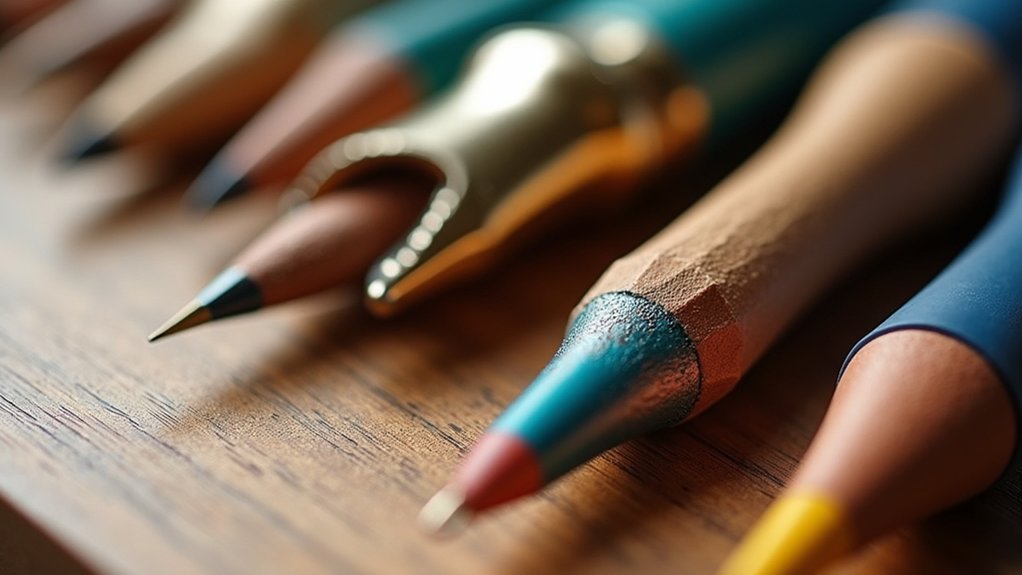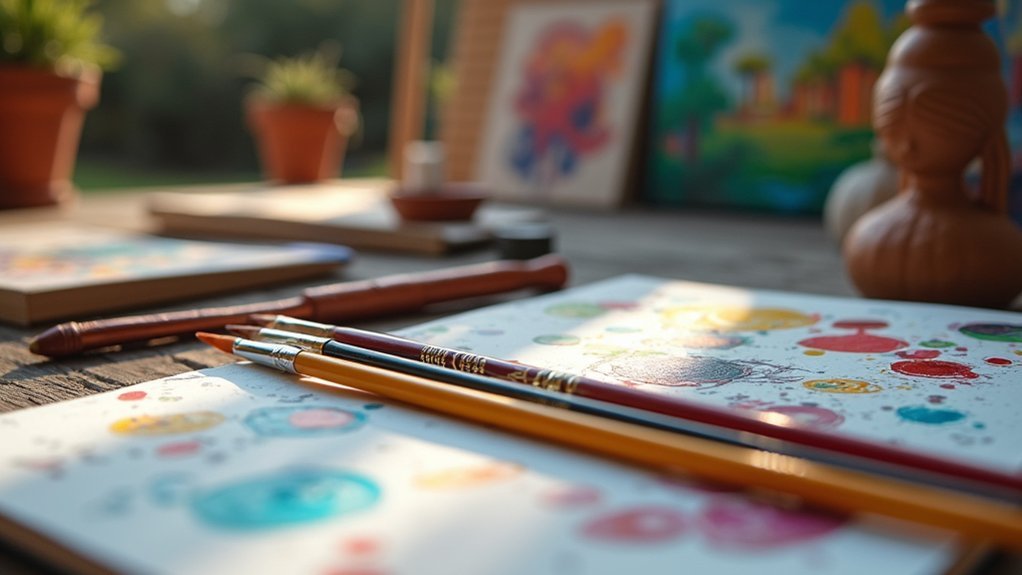Mastering weighted art tools boosts your coordination and control. Start with proper tool selection based on weight distribution, then practice stabilization techniques to build muscle memory. Try adaptive grips like foam handles or EaZyHold aids for improved dexterity. Implement progressive exercises—finger push-ups and resistance bands—to strengthen your hands gradually. Alternate between weighted and regular tools in daily practice sessions, varying weights throughout the day. The journey toward artistic precision continues with each deliberate practice technique.
Selecting the Right Weight for Your Art Tools

Why does the weight of your art tools matter so much? The right weight directly impacts your control, precision, and stamina during artistic creation.
Your paper’s GSM rating determines its durability—lightweight papers (40-80 GSM) suit dry media and tracing, while heavyweight options (300+ GSM) handle wet media without buckling. Different GSM papers have unique tactile qualities that can enhance your artistic experience.
For canvas, consider the ounces per square yard based on your painting style. Lightweight canvas (7-8 oz) works for thin applications, medium weights (10 oz) suit most projects, and heavyweight canvas (12+ oz) supports thick paints and larger works.
Though specific brush weight data is limited, remember that synthetic brushes typically weigh less than natural fiber ones.
The weight distribution affects balance in your hand and can considerably influence your technique and comfort during extended sessions.
Stabilizing Techniques for Enhanced Motor Control
Beyond selecting the right weight for your tools, mastering stabilization techniques can greatly improve your artistic output. Focus on developing proprioception—your body’s awareness of movement and position—through consistent practice with weighted tools that provide tactile feedback.
Developing proprioception through weighted tools provides the tactile feedback essential for artistic precision and control.
Incorporate motor control exercises into your routine to enhance precision. These exercises build muscle memory, allowing your hand to move more fluidly across the canvas.
You’ll notice improved stability when you balance your tools properly, reducing strain on your hands and wrists. Limiting sessions to 15-20 minutes initially can prevent muscle fatigue while still building strength.
Don’t hesitate to use assistive aids when needed. Adaptive tools customized to your grip style can greatly enhance control.
As you train, your sensory integration improves, creating a feedback loop between your brain and hands that translates to more precise, confident strokes in your artwork.
Adaptive Grips and Handles for Improved Dexterity

Enhancing your artistic expression starts with selecting the right adaptive grips and handles for your weighted tools.
These specialized adaptations come in various designs—from ergonomic egg-shaped handles to customizable straps like the EaZyHold Grip Aid.
You’ll find options ranging from professional products in multiple sizes and colors to DIY solutions using household items.
Try foam hair rollers, pool noodles, or tennis balls to create larger gripping surfaces for your art tools.
These adaptations serve therapeutic purposes too, helping improve dexterity while reducing strain on smaller hand muscles.
Whether you’re recovering from a stroke or managing limited hand mobility, adaptive grips can transform your artistic experience.
For temporary solutions, consider clothespins or film canisters as quick fixes to stabilize tools and enhance your creative control.
The soft, pliable materials used in products like the NuMuv Grip-Aid provide comfort and convenience while maintaining proper hand positioning during artistic activities.
Progressive Exercises to Build Hand Strength and Coordination
Developing hand strength and coordination requires systematic training that progresses in difficulty over time.
You’ll need to incorporate exercises that target specific muscle groups while gradually increasing resistance to build the control needed for weighted art tools.
- Start with basics: Practice wrist flexion and extension exercises daily, then progress to wrist circles to improve flexibility before handling weighted tools.
- Implement progressive overload: Gradually increase weight in exercises like finger push-ups and plate pinches to strengthen your grip.
- Combine strength and coordination: Try resistance band exercises that simultaneously work on finger independence and wrist strength. Incorporate activities like stacking coins or playing board games to make your training more fun and engaging.
- Rotate between exercises: Prevent plateaus by alternating between grip strengthening, finger independence, and hand-eye coordination tasks.
Incorporating Weighted Tools Into Daily Art Practice

Once you’ve built the necessary hand strength and coordination, you’ll need to systematically integrate weighted tools into your daily art practice. Establish a consistent schedule that alternates between weighted and regular tools to maintain skill development while preventing fatigue. This approach will significantly enhance your hand to eye coordination with regular practice.
| Time Frame | Tool Type | Focus Area |
|---|---|---|
| Morning | Light weights | Warm-up exercises |
| Midday | Regular tools | Apply techniques |
| Evening | Heavier weights | Strength building |
Set specific goals for each session, whether it’s mastering line control or enhancing brush strokes. Remember to incorporate proper breaks to avoid strain. You’ll notice improvements in your precision and expression as your muscles adapt to the resistance. Customize your weighted tools to suit your specific artistic needs—you might find that different weights work better for different techniques.
Frequently Asked Questions
Can Weighted Tools Help With Specific Learning Disabilities?
Yes, weighted tools can help you with specific learning disabilities by improving your hand-eye coordination, fine motor skills, and sensory integration. They provide feedback that helps strengthen muscles and enhances your dexterity for writing tasks.
How Long Before Improvements in Coordination Become Noticeable?
You’ll typically notice coordination improvements within 3-6 weeks of consistent practice. Your progress depends on practice frequency, intensity, and your unique neurological profile. Some subtle changes may appear even earlier.
Are Weighted Tools Beneficial for Adults With Arthritis?
Yes, weighted tools can benefit you if you have arthritis. They help improve your grip strength, enhance coordination, assist with pain management, and maintain fine motor skills while providing comfortable, adaptable options for your hands.
Can Children Under Five Safely Use Weighted Art Tools?
You should generally avoid giving weighted art tools to children under five. They’re still developing motor skills and coordination, and the extra weight may cause strain or potential safety hazards without proper supervision.
Do Weighted Tools Affect Artistic Style or Expression?
Yes, weighted tools can greatly influence your artistic style. You’ll notice changes in your brushstrokes, line weight, and precision. They’ll affect your physical technique, which directly impacts your creative expression and visual outcomes.
In Summary
You’ve now mastered the essentials of weighted art tools for better coordination. By choosing appropriate weights, implementing stabilization techniques, adapting your grip, practicing strengthening exercises, and making weighted tools part of your routine, you’ll notice significant improvements in your artistic precision. Don’t rush the process—your hand-eye coordination will develop gradually. Stay committed to these practices, and you’ll soon enjoy steadier lines and more controlled artistic expression.





Leave a Reply